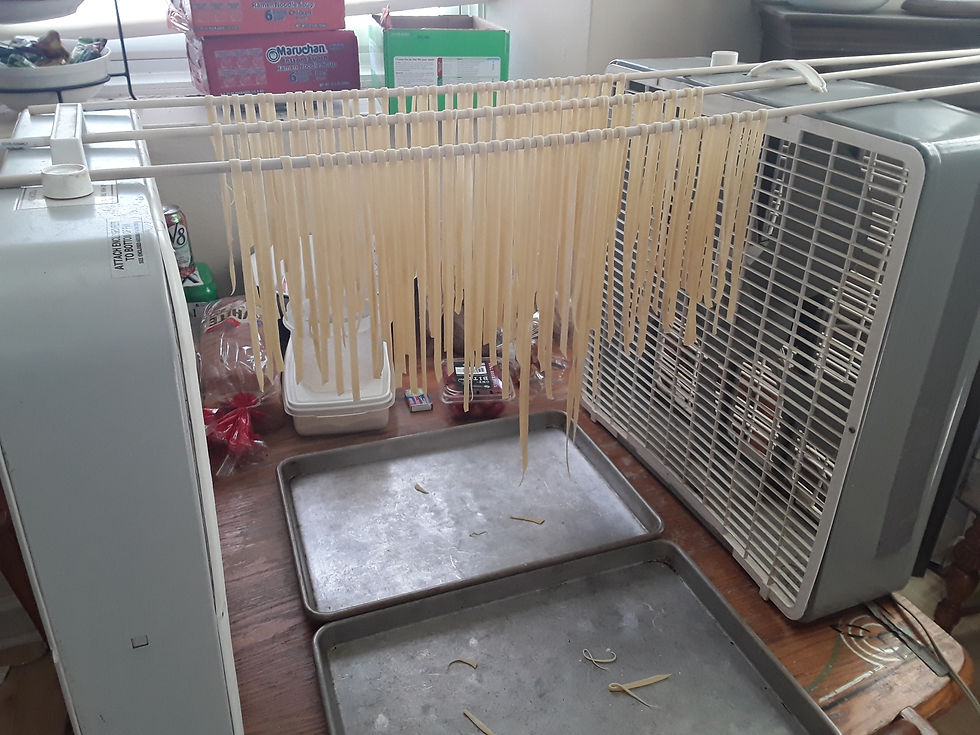As we slowly expand our food production, a future step will be to have chickens for eggs and meat. While Maggie loves eggs, I am not a fan. That raises an important question: what will we do with all of the eggs these future chickens will produce? Although we are counting eggs before they are laid, we had a recent surplus of eggs when my mom gave us an 18-egg carton during the holiday. There is one product that can be made with eggs and stored, which is noodles.
When looking for recipes, there seems to be two groups of sources. One group consists of professional publications such as Bon Appetit and America's Test Kitchen. The other group is anyone with a blog or YouTube channel. These sources can diverge wildly for complex recipes. For noodles, there seemed to be general agreement, likely through a combination of a short list of ingredients, and people borrowing recipes from each other and re-posting them. We have a set of KitchenAid pastamaking attachments, which I used to make a couple of batches of pasta noodles using the following recipe from Bon Appetit:
Three Eggs, Beaten
Two Cups All-Purpose Flour
One Tablespoon Olive Oil
One Teaspoon Kosher Salt
The steps are simple: 1) mix ingredients together, 2) wrap dough with plastic wrap and let rest for at least 30 minutes, 3) Divide dough and make into noodles following the directions for your pastamaking machine.
There is one secret ingredient, which is water. Most doughs for noodles, breads, and pie crusts call for some amount of water. Baking usually involves closely following the recipe, but the amount of water can vary. I find this to be a point of frustration with dough recipes as they tend to include the smallest possible amount of water that will work, which will often lead to failure for first-time bakers. I usually end up tripling the amount of water called for in my base pie crust recipe. The reason for the variation is that flour will need differing levels of hydration depending on the moisture in your kitchen. This is usually poorly explained in recipes, if mentioned at all. When making my noodle dough, I simply added water a tablespoon at a time until the dough came together, and was slightly sticky but not wet.
After the noodles are made, they can be used fresh, laid out into little nests and frozen, or hung to dry. You can buy a noodle drying rack for under $25 from Crate and Barrel, which I do not usually think of as synonymous with bargains. For my first batch, I placed a broomstick between the two doors of our entertainment center, put the noodles on plastic clothes hangers, and hung the laden hangers from the broomstick.
Which leads to a funny story. When I came downstairs at 5AM to let the dog out, I found most of the noodles on the floor. According to the internet, noodles can dry quickly and unevenly in the winter, resulting in cracking where they lay across the hanger. Interestingly, Maxie did not eat the noodles off the floor, but I can only imagine what she thought as noodles rained down throughout the night.
After several weeks passed, I tried again. This time, I placed two box fans on the kitchen table, laid several wooden dowel rods across, and hung the noodles on the dowels. I placed cookie sheets under the noodles to catch them if they broke. This time, the noodles dried and did not break off the dowels. My theory is that the wood of the dowels absorbs some moisture from the noodles, and releases it back into the noodles as they dry. More experiments are needed.

As a parting note, there is some disagreement as to whether it is safe to store egg noodles without freezing, since the eggs are uncooked. Most articles I read indicate dried pasta can be stored in an airtight container for 2 to 6 months. Some claim the salt in the noodles acts as a preservative. The KitchenAid recipe book has a warning, in bold letters, against eating things made with unrefrigerated eggs. Follow what you are comfortable with.
Comentarios